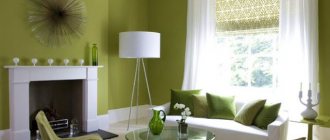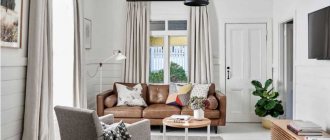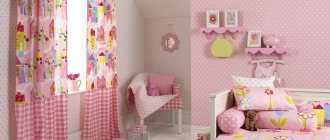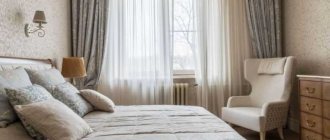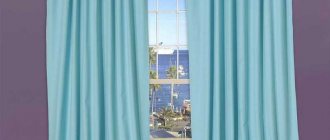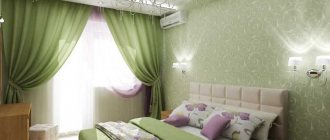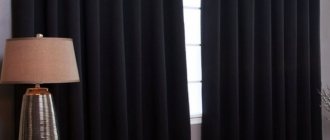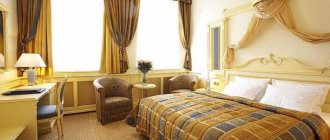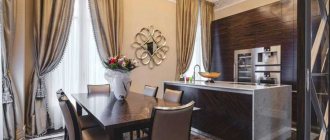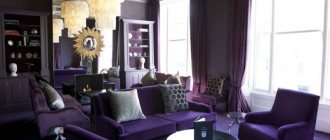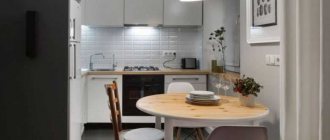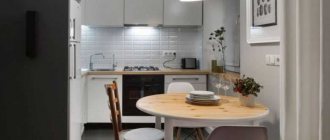Lush Viennese (Austrian) curtains fit into the interior of apartments, offices, and large halls. The curtains, decorated in an elegant style, gather in graceful folds. When lowered, the curtains become rectangular sheets and take up minimal space in the window area.
What are Viennese curtains
Curtains in a similar style appeared in the 18th century. The principle of operation came from Roman curtains, and the elegant appearance from French curtains. The products are a rectangular sheet attached to a cornice. Cords run vertically along the entire length of the material, with the help of which the fabric can be gathered into folds and scallops or raised.
Difference from French curtains
Austrian curtains are a flat fabric gathered along the bottom edge. This is their main feature. When raised, the straight fabric gathers into lush tails. The material consumption for sewing such products is economical.
French curtains have voluminous folds running along the entire length of the fabric. When collected they are lush, but when lowered they are soft and wavy.
Fabrics and accessories for sewing Austrian curtains
The required list of materials presented below applies to sewing lined Austrian curtains with at least 3 rows of scallops. These curtains are attached to the outside of the window opening on the cornice.
Curtain sizes can be adjusted to suit different window sizes. Their side and bottom edges are trimmed with ruffles 7.5 centimeters wide.
- A profile cornice or wooden rod is 20 cm longer than the width of the window.
- Light curtain fabric: voile, organza, chiffon, taffeta and other fabrics.
- Lining fabric.
- Mounting tape. Dimensions: length of canvas + one more length for scallops.
- Nylon cord. Approximately two curtain lengths + one width for each drapery strip.
- Adhesive curtain tape. Approximately twice the length of a profile cornice or wooden cornice rod.
- Curtain tape for attaching the top of the curtain fabric along the length of the rod or cornice.
- Wall cornice, cord end clamps, plugs.
- Brackets for a profile cornice or brackets are the eyes of a wooden rod.
- Curtain hooks for hanging curtains.
Suitable fabrics
For tailoring, soft, well-draped materials are selected. They can have different densities and ability to transmit light. When choosing fabrics, it is important to take into account the style of the interior, the overall color scheme and the direction of the world on which the windows face.
Tulle
The translucent material drapes easily and lets in a lot of light. Viennese curtains made from this fabric are complemented with classic curtains or lambrequins.
Veil
The rare-woven mesh fabric drapes beautifully, allowing you to create graceful folds. The lower edge of curtains made of this material is decorated with lace, glass beads, and hand stitching.
Organza
Thin translucent fabric is stiffer than tulle. It is assembled into voluminous, breakable folds, thanks to which curtains made from it fill the room with light and give it a special charm.
Guipure
Openwork material is chosen for sewing Viennese curtains if it is necessary to focus attention on the windows. It is decorated with tassels or fringe, giving the interior a solemn look.
Linen
The natural material forms uniform deep folds. It protects the room from prying eyes and excess sunlight.
Velours
Viennese curtains made of this material give the interior a solemn look and are used when decorating windows in large rooms. They are complemented with tassels, lambrequins, cords, and fringe.
We select Austrian curtains for your kitchen
Austrian curtains are very relevant and can be easily used in any interior, and they can also be combined with elongated classic curtains. When choosing elegant curtains, you should consider their advantages.
- Firstly, they take up little space, which means they are suitable for even the smallest kitchen.
- Secondly, the fabric consumption for sewing Austrian jackets is much less than for classic ones.
- Thirdly, when the window in the kitchen is located near the table or stove, then Viennese curtains will not interfere, since they are easy to raise and then lower.
- Fourthly, such elegant curtains will transform your kitchen and give it a presentable look.
Suitable interior styles for application
Austrian-style curtains are used to decorate rooms in classic and modern styles. In combination with the rest of the decoration, they help set accents and give the room a well-groomed look.
Provence
For an interior in this style, samples made of simple linen fabrics with a checkered, striped or floral pattern are suitable. Such curtains maintain the overall atmosphere and refresh the look of the room.
Vintage
When decorating windows in the interior of such a room, Viennese curtains made of flowing materials in the spirit of old times (brocade, velvet, velor, silk, taffeta) are used.
The main task is to choose the length and shade of the curtains and form the drapery.
Classical
Austrian-style curtains are used to decorate windows in large rooms. They are made from translucent materials, the light drapery of which looks sophisticated.
Modern
These curtains add a touch of chic to a modern setting. They are sewn from thin transparent fabrics that give the room lightness.
American
Austrian curtains made of opaque materials with small ornaments or geometric patterns will allow you to emphasize the neatness and presentability inherent in this style.
They can have a simple cut and barely visible drapery along the edge.
Fabric colors
When choosing a pattern and color of a material, it is important to take into account the features of the interior, the area of the room and the degree of its illumination. It is not necessary to use plain fabrics.
With flowers
Flowers on the curtains soften the atmosphere and bring a feeling of celebration. Light and sophisticated designs create a joyful and soulful atmosphere in the interior.
Floral patterns
When decorating windows, designers often use curtains with fashionable patterns. The canvases contain curls, vines, leaves, petals and other natural elements.
Ornaments
Original drawings focus attention on the windows and transform any room. Viennese curtains with patterns add sophistication and charm to the simplest furnishings.
Geometry: stripe, check
Curtains with clear geometric patterns add laconicism and rigor to the decor. They are appropriate in living rooms, offices, and kitchens. Light draperies and waves along the edge soften the overall appearance.
Design and drawings
When choosing a pattern for curtains, it is important to understand that not every pattern will suit a specific room design. So, for example, if the entire room is made in a classic, strict style, “cheerful” colorful Austrian women with floral patterns are unlikely to fit into it.
With flowers
Flowers are always a holiday. This is exactly the environment that products decorated with floral patterns present. Seeing such paintings, a feeling of joy and tenderness arises. Viennese curtains with flowers will look appropriate on balconies, loggias, kitchens, as well as in living rooms or bedrooms. However, you need to take into account the color of the paintings, the pattern and the main elements of the room.
Floral patterns
Today, the most fashionable designers in the world quite often use canvases depicting branches, leaves or vines in their masterpieces. Such Viennese curtains look great both in spacious living rooms and in small kitchens and balconies.
Ornaments
The use of various ornaments and simple figures in Austrian women draws attention to the windows and makes the room more sophisticated. This solution will make even the simplest room brighter and more expressive.
Multilayer
Such Austrian curtains, as a rule, consist of several panels. To achieve greater effect, they are complemented with translucent drapery and a classic lambrequin.
On bows
Bows are often used to decorate curtains. They are also able to provide slight sagging on the sides of Austrian curtains. Canvases with this decor can be used in any room.
Lace
Lace makes any product warm, light, and attractive. Austrian lace curtains can make a room airy, light, and delicate. For better effect, they are often combined with curtains made of heavy and dense fabrics.
Geometry stripe cage
Strict geometric lines in Austrian women make them more attractive. Moreover, such curtains can be combined with almost any style in the interior.
With bugles
Bugle beads are a beautiful addition to any curtain. In combination with Austrian curtains, they make the room elegant and glamorous, especially if crystal or Swarovski crystals are used for decoration.
From threads
A very sophisticated way to decorate any room. Viennese canvases made from threads look cute and make the room romantic and airy.
Design and decor options
The products require a cornice with a lifting mechanism. They come with tight cords that are attached from the inside out and ensure uniform drapery.
Multilayer
Such curtains are created from several canvases that are harmonious with each other in shade and design. A popular combination of thick and translucent fabric, complemented by a lambrequin and draperies.
On bows
In this interpretation, the fabric flows freely, and the drapery is decorated with beautifully tied bows. By fixing the folds, they give the window decor a festive look.
Lace
The use of openwork elements brings warmth and lightness to the interior. Austrian curtains decorated with lace are usually combined with thicker types of curtains.
With bugles
Fittings and fringe with glass elements are used to give the room a light and glamorous look. Such fittings are combined with accessories made of crystal and Swarovski crystals.
From threads
Elegant and thin, like a cobweb, canvases allow you to create interesting decorative solutions. Such curtains look especially impressive in the decoration of living rooms and restaurant halls.
Useful tips
“Austrian women” look unusual and elegant with braid sewn only in their central part, but not on the sides. This will allow the edges of the fabric to hang freely, giving the window a sophisticated and glamorous look.
For “Austrians”, hidden or inconspicuous cornices are best suited. They visually enlarge the room and do not draw attention to themselves, emphasizing the elegant beauty of the curtains. This rule is especially true for small kitchens with small windows that do not tolerate unnecessary details that weigh down the space.
Curtains combined from two fabrics of different texture and color look good on any window. For their basis, transparent organza or tulle is taken, and as a complement, a material that matches the style of the kitchen interior. Such a curtain should not be collected in numerous folds. It is better to decorate it with thin ribbons and small bows.
It is customary to decorate the door to a balcony or loggia with a long curtain. So that it does not stand out from the general design concept of the room, it is complemented with a short Austrian curtain, reminiscent of a lambrequin and similar in shape and texture to the curtain on the window.
In 2020, Austrian curtains are back in fashion again. The new is the well-forgotten old. Good old Austrian curtains have brought elements of novelty and sophistication to modern interiors. Thanks to the ability to constantly change their shape, you can change the appearance of the kitchen, filling even the most ordinary and inexpressive environment with bright and original colors.
Mounting options for cornice
There are several options for attaching Viennese curtains:
- to the ceiling;
- wall above the window;
- cornice;
- frame;
- slope above the window.
Curtains can come complete with a curtain rod equipped with a closed or open lifting mechanism.
Velcro
To hang light canvases on the cornice strip, fastening with Velcro tape is used. It consists of soft and hard parts and is attached to a window, wooden plank or wall. When fixing to the cornice, loops are used.
With strings
Curtains with loops and ties look original in the interior. Curtains are secured to the curtain rod using cords, ribbons or textile strips, which are tied with a bow or beautiful knots.
Master class on sewing Austrian curtains with your own hands
Before work you should prepare:
- sewing machine;
- scissors;
- threads matching the color;
- base for curtains;
- braid or tightening tape;
- nylon cord;
- curtain tape.
Lining fabric is required if necessary.
Choice of fabric and design
If priority is given to pronounced folds, emphasized shapes and accentuated flounces, you should purchase dense, smooth fabrics (satin, linen, satin). When smooth, wavy transitions are needed, you should focus on flowing fabrics (silk, velor, tulle).
How to determine dimensions
The width of the finished product should be 2 times the length of the cornice. The dimensions of the model are calculated by their location on the window. The length of the product is calculated depending on how the curtain will hang. If the curtain is straight when lowered, it is equal to the distance from the cornice to the floor.
When determining the length of the cord, the number of gathering strips is multiplied by the size of the fabric allocated for folds. Take into account how much the cord will exceed the edges of the fabric. The resulting values are added and multiplied by the number of stripes.
Step-by-step instruction
Before cutting, you should familiarize yourself with the drawing of the curtain, and also steam the prepared fabric.
Main stages of sewing:
- Cut a piece of fabric of the required size, taking into account allowances.
- Using the pattern, mark with chalk where the curtain tape goes.
- Topstitch the side hem.
- Hand sew the braid into place.
- Fold the fabric over 5 cm and stitch.
- Attach a ribbon along the seam for hanging.
- Turn it inside out and stitch.
- Process and decorate the bottom edge according to the design plan.
- After each line, iron the fabric.
On the finished product, carefully tighten the tape and secure the cords. Assembly will be facilitated by a lifting mechanism that is inserted from the side and attached to the top of the cords.
Curtains made from ready-made curtains
Using the principle described above, you can alter curtains from old curtains. It is recommended to decorate them with fringe, bows or braid.
An easy way to drape Austrian curtains
A modern way to give Viennese curtains an attractive look is to use drapery tape. It is sewn on the sides of each row of folds. The braid can be carefully tied and periodically unraveled, resulting in a smooth fabric.
Photos of Austrian curtains
Read here Italian curtains: 70 photos of the design embodiment of the Renaissance
Did you like the article? Share 
In which rooms can you use photos in the interior?
Viennese-style curtains fit effectively into almost any living space, including offices and bathrooms. Photos of the interiors will allow you to verify this.
In the living room
In rooms with large windows, brightly colored curtains can be used as an accent. A combination with tulle will help emphasize the richness of the cut and material.
In the bedroom
Curtains made of pastel-colored fabrics will create a romantic atmosphere. They will be complemented by translucent flowing curtains.
In the nursery
Light tulle with cheerful patterns is suitable for a preschooler's nursery. At an older age, girls are given fabrics in pastel shades, decorated with fringe and lace. The solution for boys is curtains in calm colors.
In the kitchen
The optimal length of curtains is up to the window sill. When choosing the type of fabric, you should prefer synthetics: it absorbs odors less and is resistant to stains.
In the office
Austrian curtains in a classic style are selected for work spaces and business offices. Dark, soft colors and lack of decor are preferred.
In public places
Viennese style is a suitable idea for decorating restaurant halls and marriage registrations, theater foyers, dining rooms and other public places. When holding corporate events, it is appropriate to decorate windows with silk curtains and veils.
Application options for non-standard shaped windows
Window openings of unusual shape (rectangular, arched, bay windows) are a bright accent of the interior. When decorating them with the help of Austrian curtains, original solutions are used.
On an arched window
Viennese curtains are used to decorate arched windows of any shape. The main task is their correct installation and compliance of the design with the overall concept of the room.
Bay window
When decorating windows located in a room that extends beyond the plane of the facade, you should choose multi-layer curtain options. A good solution is a combination of thick curtains with Viennese curtains made of translucent fabric in suitable shades.
Window with balcony door
The use of fabrics of different densities allows you to hide the exit to the balcony and at the same time let in enough light. The structure is made according to the size of the opening.
On the windows along the stairs
Tall windows along staircases in palaces, cottages and other spacious rooms are highlighted using asymmetrical compositions. When decorating, light and elegant materials are used, which give the atmosphere a solemn and pompous look.
Dimensions
To make Austrian curtains look beautiful and harmonious, you need to choose their size wisely. There are several generally accepted standards, following which you can make your curtains more attractive:
- the length of the material before sewing the product should be 2 times the size of the cornice;
- so that when closing the curtains are straight, make sure that the length of the material corresponds to the distance from the curtain rod to the floor;
- To ensure that the fabric drapes when closed, its length is chosen taking into account the desired size of the folds.
It is also important to consider the overall length of Austrian curtains. They can be below the window sill (long) or above (short).
Long
Long Austrian curtains are an indicator of wealth and luxury. To ensure the full effect of such curtains, they are combined with heavier curtains and different types of decorations are added: glass beads, lambrequins, fringe and others. Most often, such curtains are installed across the entire width of the wall on which the window opening is located.
Short
Short Austrian curtains are practical and very popular. Most often they are installed in bathrooms or in the kitchen, because the area of contamination on such canvases is significantly reduced, which allows them to be installed above sinks and near bathtubs, without fear of quickly staining or splashing the material.
In addition to their practicality, short canvases look very stylish, regardless of the type of interior.
